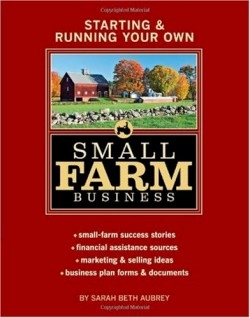Starting & Running Your Own Small Farm Business
The fable of an elephant confused for something else by blindfolded people who inspect one area each can be applied to the next generation of family farms. Corn mazes, cider mills, community plots, and wine tasting rooms are all in the evolving mix of attractions farmers use to reinvent a plausible living. It’s time for innovation, and past time to apply proven business systems.
Aubrey identifies the bedrock reason small farmers stay in such a challenging sector: they love the homeplace too much to part with it, and they chronically dread doing anything else. The author herself walked away from a financial planner’s desk because going to work caused emotional distress. But an education in agriculture only partly prepared her for the ups and downs encountered launching an Indiana concern which supplies chemical-free beef to upscale restaurants.
Concentration on commodity crops for wholesale markets is a losing proposition, as massive conglomerates like Monsanto and Archer Daniels Midland drive prices down through economies of scale and soak up a majority of government crop subsidies. Smarter routes to black ink are through niche marketing, and transformation of traditional working farms into “agri-entertainment” destinations. Direct links to end-consumers are necessary for growth, whether through the farmers’ markets or the sale of value-added products on the internet.
Worries about hormones and contamination of the food supply cause customers to put money and word-of-mouth support behind more environmentally sustainable operations. Nothing grants consumers peace of mind like visiting the places where food originates and having their concerns addressed by the farmer herself.
Chapter-heading epigrams position Small Farm Business within a tradition of progressive populism, highlighting agrarian pensmiths such as Willa Cather, Wendell Berry, Laura Ingalls Wilder, and Ralph Waldo Emerson. Profiles of successful small farms are the showpieces of each chapter. Aubrey’s writing has a readable adver-cational quality, but she doesn’t unduly promote her farm’s brand of high-end beef sales so much as she advocates modernization and entrepreneurship. A section comparing retail to wholesale falls short of adequate clarity.
The application of common planning models is a necessity. Continuing education seminars are recommended, serious market research before taking the plunge is a must, and available grants reward progressive practices. Not endorsed: fighting with regulators or relying on the whims of a single buyer for survival. This book focuses on setup and the first year of operation. Great tips for newbies who need to determine the feasibility of following their dreams, and still helpful to those who have been at it awhile.
Reviewed by
Todd Mercer
Disclosure: This article is not an endorsement, but a review. The publisher of this book provided free copies of the book to have their book reviewed by a professional reviewer. No fee was paid by the publisher for this review. Foreword Reviews only recommends books that we love. Foreword Magazine, Inc. is disclosing this in accordance with the Federal Trade Commission’s 16 CFR, Part 255.

